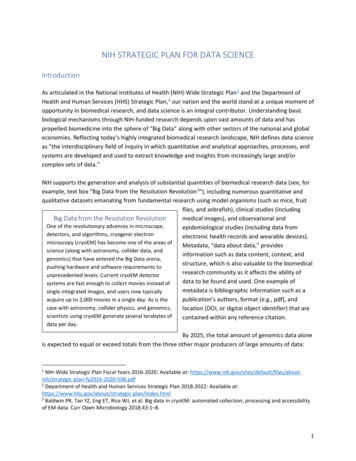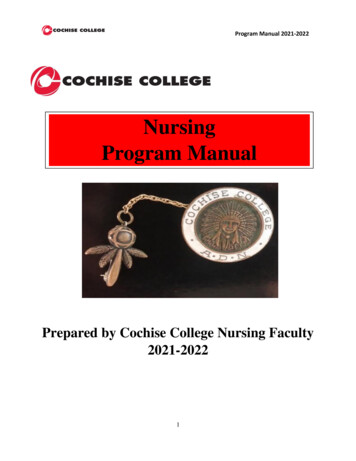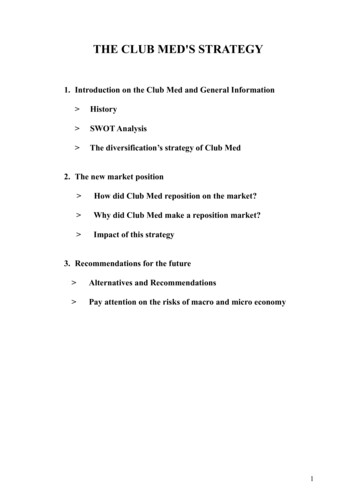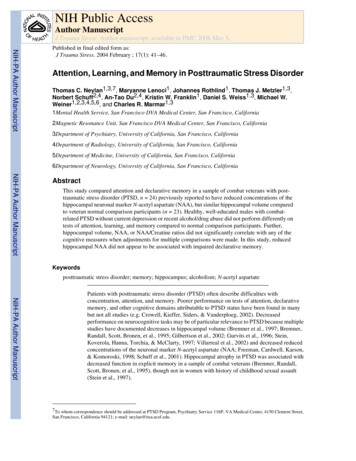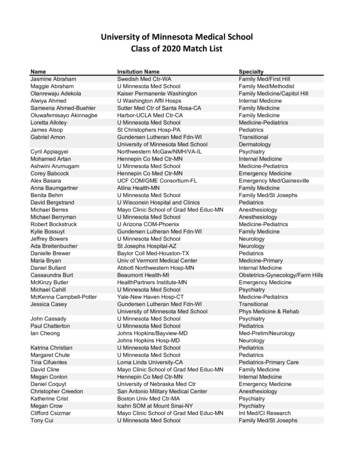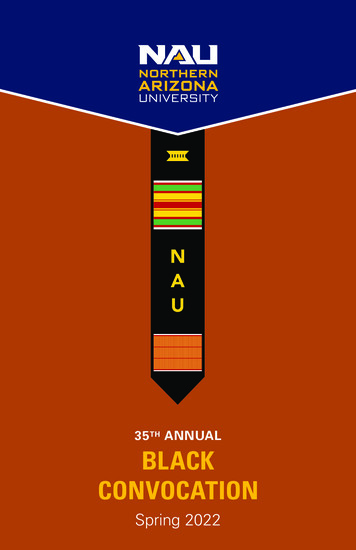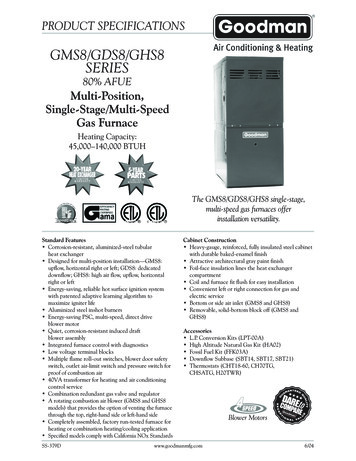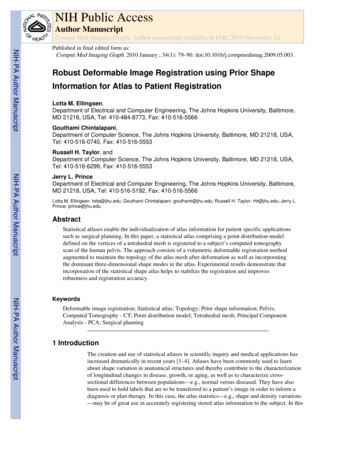
Transcription
NIH Public AccessAuthor ManuscriptComput Med Imaging Graph. Author manuscript; available in PMC 2010 November 23.NIH-PA Author ManuscriptPublished in final edited form as:Comput Med Imaging Graph. 2010 January ; 34(1): 79–90. doi:10.1016/j.compmedimag.2009.05.003.Robust Deformable Image Registration using Prior ShapeInformation for Atlas to Patient RegistrationLotta M. Ellingsen,Department of Electrical and Computer Engineering, The Johns Hopkins University, Baltimore,MD 21218, USA, Tel: 410-484-8773, Fax: 410-516-5566Gouthami Chintalapani,Department of Computer Science, The Johns Hopkins University, Baltimore, MD 21218, USA,Tel: 410-516-0740, Fax: 410-516-5553Russell H. Taylor, andDepartment of Computer Science, The Johns Hopkins University, Baltimore, MD 21218, USA,Tel: 410-516-6299, Fax: 410-516-5553NIH-PA Author ManuscriptJerry L. PrinceDepartment of Electrical and Computer Engineering, The Johns Hopkins University, Baltimore,MD 21218, USA, Tel: 410-516-5192, Fax: 410-516-5566NIH-PA Author ManuscriptKeywordsLotta M. Ellingsen: lotta@jhu.edu; Gouthami Chintalapani: gouthami@jhu.edu; Russell H. Taylor: rht@jhu.edu; Jerry L.Prince: prince@jhu.eduAbstractStatistical atlases enable the individualization of atlas information for patient specific applicationssuch as surgical planning. In this paper, a statistical atlas comprising a point distribution modeldefined on the vertices of a tetrahedral mesh is registered to a subject’s computed tomographyscan of the human pelvis. The approach consists of a volumetric deformable registration methodaugmented to maintain the topology of the atlas mesh after deformation as well as incorporatingthe dominant three-dimensional shape modes in the atlas. Experimental results demonstrate thatincorporation of the statistical shape atlas helps to stabilize the registration and improvesrobustness and registration accuracy.Deformable image registration; Statistical atlas; Topology; Prior shape information; Pelvis;Computed Tomography - CT; Point distribution model; Tetrahedral mesh; Principal ComponentAnalysis - PCA; Surgical planning1 IntroductionThe creation and use of statistical atlases in scientific inquiry and medical applications hasincreased dramatically in recent years [1–4]. Atlases have been commonly used to learnabout shape variation in anatomical structures and thereby contribute to the characterizationof longitudinal changes in disease, growth, or aging, as well as to characterize crosssectional differences between populations—e.g., normal versus diseased. They have alsobeen used to hold labels that are to be transferred to a patient’s image in order to inform adiagnosis or plan therapy. In this case, the atlas statistics—e.g., shape and density variations—may be of great use in accurately registering stored atlas information to the subject. In this
Ellingsen et al.Page 2paper, we use shape information contained within a three-dimensional (3D) statistical atlasto inform the registration of the atlas to a subject.NIH-PA Author ManuscriptStatistical models of shape have been most commonly constructed using point distributionmodels (PDMs) to characterize the shape variations that are present in curves in 2D orsurfaces in 3D [5–7]. In such cases, variants of the active shape models are typically used toregister an atlas to a given subject [8]. In this work, we are concerned with a threedimensional statistical atlas of the human male pelvis, conceptually similar to that proposedby Yao and Taylor [1] and also described in [9]. It comprises a tetrahedral mesh whosevertex positions are described by a PDM and whose CT densities are characterized by thecoefficients of Bernstein polynomials. With the registration of many subjects, principalcomponent analysis (PCA) [6] can be computed on both shape and density variations, andthe dominant modes of variations can be learned and used.NIH-PA Author ManuscriptThe specific task being addressed in this paper is the segmentation of the pelvis from CTdata. While low level segmentation methods can be used, extraneous and highly variabledetails within these images, including the presence of barium contrast in the bowel, thepresence of and the variable positions of the femurs, and the variation in CT tablepositioning, can make this task difficult, ultimately requiring human monitoring andintervention. High level segmentation, such as the “segmentation-by-registration” processdescribed herein, requires information that guides the process in order to make it robust tothese extraneous influences but should not be so constraining that detail is missed andfidelity lost. In our approach, the use of an atlas helps to provide the required robustness toextraneous features while the use of strong image features guarantees faithfulness to thesubject’s data.The method presented in this paper, which we refer to as Mjolnir , is an extension of thevolumetric deformable registration method called Mjolnir [10], which in turn was modeledafter the registration method HAMMER [11]. In particular, we augmented Mjolnir both toincorporate the dominant 3D shape modes in the statistical atlas and to maintain thetopology of the atlas mesh after deformation. In extensive experiments, we demonstrate thatthese extensions can significantly enhance algorithm robustness, yielding a pelvissegmentation result that is consistently reliable and accurate in CT data having highlyvariable characteristics and overall quality.2 Statistical AtlasNIH-PA Author ManuscriptWe are concerned with a 3D statistical atlas of the human male pelvis comprising twofeatures: 1) a model tetrahedral meshhaving NV vertices and NT tetrahedra describingthe shape of the mesh, and 2) CT densities which give its likely appearance within a CTimage. These characteristics are illustrated in Fig. 1. For convenience in describingstatistical variation of shape, the positions of the mesh vertices are stacked in a vector 𝐦̅ ℝV, where V 3NV. The actual 3D position of the i-th vertex is given by 𝐯̄i (m̄i, m̄i NV,m̄i 2NV) ℝ3, where m̄i is the i-th element of 𝐦̅. The CT densities are defined on the modeltetrahedra by specifying coefficients of Bernstein polynomials on the barycentric griddefined by the vertices, as described in [1]. In this version of the atlas, only shape ischaracterized by statistical variation; the CT densities are assumed to be constant andknown.The statistical atlas was constructed according to standard procedures in principalcomponent analysis (PCA) of shapes (see [6]) from 41 normal male pelvis CT scans. OneCT scan was randomly selected to serve as a template pelvis. The pelvic bone of this imagewas manually segmented and a 3D tetrahedral mesh, comprising 26875 vertices andComput Med Imaging Graph. Author manuscript; available in PMC 2010 November 23.
Ellingsen et al.Page 3NIH-PA Author Manuscript105767 tetrahedra, created from the segmentation using the method by Mohamed andDavatzikos [12]. The remaining 40 CT scans were deformably registered to the templatepelvis using Mjolnir [10], modified to register pelvis CT images and augmented to deformand preserve the topology of the template mesh (as described in Sections 5 and 6 below).This procedure provided topologically correct mesh instances , i 1, , 40, for eachsubject, thereby deriving 26875 corresponding landmarks between each scan and thetemplate pelvis (see details in [9]). After PCA analysis, the first M principal modes ofvariation (where M 15 in our experiments) were arranged in a V ( 3 26875) by Mmatrix ΦM [φ1 φ2 φM], from which a shape instance can be generated according to(1)by choosing mode weights b ℝM [13]. During the execution of Mjolnir , we iterativelysearch for b that yields a shape instance from the atlas that best matches the actual subjectshape. The displacements m 𝐦̅ defined on the model shape then provide guidance thatallows Mjolnir to robustly and accurately bring the atlas and subject into alignment (seeSection 4).NIH-PA Author ManuscriptIn order to analyze the size of the population and the number of principal modes needed toextract stable statistics, we randomly selected n meshes, where n 20, 30, , 80, andcreated statistical atlases using these datasets. This process was repeated 20 times for eachvalue of n. After registering the atlas to multiple leave-out subjects (yielding “true shapes”)and estimating the given subjects using the atlas modes, we computed the vertex to vertexcorrespondence error between the estimated shapes and the true shapes. We then computedthe average residual vertex correspondence error for each of the atlas sizes as a function ofnumber of modes. This analysis revealed that around 40 to 50 datasets are sufficient tocapture the shape variations of a healthy pelvis anatomy using 15 modes. Adding moreinstances to the atlas database resulted in a very small improvement, less than 0.1mm, interms of residual errors (see details in Chintalapani et al. [9]).3 Key ConceptsNIH-PA Author ManuscriptThe 3D-3D deformable registration approach presented in this work, referred to as Mjolnir ,is based on a method called Mjolnir (see [10,14] and [11]). In this section, we review thekey concepts that are largely in common between these methods and also highlight certaindifferences that are used to take advantage of the presence of the statistical atlas in Mjolnir .For further details about those processing steps that are in common between these methods,the reader is referred to [11] and [14]. A block diagram of Mjolnir is provided in Fig. 2.Attribute VectorsThe goal of the registration algorithm is to spatially align atlas and subject images. In orderfor this alignment to be accurate and anatomically correct one must identify correctanatomical correspondence between the two images. Several geometric moment invariants(GMIs) are computed at a small neighborhood around each voxel in both images. Thesemoments describe the intensity “shape” near each voxel. The CT intensity and the edge,derived from the classification of the pelvis CT image into soft tissue, trabecular bone, orcortical bone (see Section 6) are also used as features to be matched. All these pieces ofinformation about each voxel are organized into attribute vectors, one for each voxel. Thisinformation will figure into the image similarity after registration. This procedure is done atthree resolutions of each CT image—coarse, medium, and fine—and the subsequent stepsare performed in sequence from coarse to fine.Comput Med Imaging Graph. Author manuscript; available in PMC 2010 November 23.
Ellingsen et al.Page 4Driving VoxelsNIH-PA Author ManuscriptDuring the execution of Mjolnir , a collection of driving voxels from both atlas and subjectare determined. These are distinctive voxels in one image—as determined by their attributevectors—that can be associated with similar points in the other image creating temporarylandmark pairs that “drive” the deformation of one image toward the other. Driving voxelsare “active” while all other voxels are “passive” because the displacement field at eachiteration is determined solely by the displacements that are estimated at driving voxels. InMjolnir, driving voxels are automatically selected in a hierarchical fashion, starting with asmall initial set of highly distinctive voxels in both the atlas and the subject images. InMjolnir , the initial set of driving voxels comprises a small collection of highly distinctivevoxels residing on mesh vertices rounded to the nearest voxel; these voxels are mostlylocated on high curvature points on the pelvic bone like the iliac crests (see Fig. 3).NIH-PA Author ManuscriptIn later iterations, Mjolnir augments the driving voxels in two ways. First, voxels in theimmediate 6-neighborhood of existing driving voxels are added; in this way, the registrationof edges and corners are made more precise over increasing neighborhoods around originaland added driving voxels. Second, new driving voxels from increasingly less distinctivepoints on the mesh—i.e. voxel points near mesh vertices—are added; in this way, theinfluence of the image attributes on and near the mesh continues to demonstrate highinfluence on the registration process. Highly distinctive points within the subject image arealso selected as driving voxels. In this way, important points in the subject that should play amajor role in registration are also incorporated in the registration process. In each iteration,the subject image is deformed relative to the atlas image, and new driving voxels areidentified in order to continue to bring the images into alignment. Various thresholds arechanged throughout the registration process such that all voxels in the atlas image —andhence, all vertices rounded to the nearest voxel — eventually become driving voxels. Forcomputational savings, the driving voxels in the subject image are never augmented toinclude more than just the original selection.CorrespondencesFor each driving voxel in the subject and atlas images, a corresponding voxel in the otherimage is found, creating a (temporary) landmark pair. This is performed by searching in theopposite image for voxels with strongly similar attribute vectors. The search is performed ina spherical neighborhood around each driving voxel. The radius of the neighborhood is largein the beginning when the subject and atlas are far apart and gradually decreases to a singevoxel as the image alignment converges.NIH-PA Author ManuscriptDisplacement FieldAfter searching and finding correspondences for all driving voxels, including those locatedon vertices, displacement vectors pointing from the atlas to the subject are formed for eachdriving voxel, forming a sparse displacement field uc(x) for each voxel position x in thedomain of the atlas. This field is then interpolated and smoothed throughout the entire imagedomain in order to generate a dense displacement field, which yields a transformation thatcan be used to align the two images by warping their coordinate systems. In Mjolnir , weregularize the displacement field uc using prior shape information from the statistical atlasand then carry out interpolation and smoothing as in conventional Mjolnir while alsopreserving mesh topology. This new process is described next.Multi-resolution schemeThe algorithm is run at three different resolutions, i.e. low, medium, and high (see Fig. 2).At low resolution, the images are downsampled by a factor four and the algorithm is runComput Med Imaging Graph. Author manuscript; available in PMC 2010 November 23.
Ellingsen et al.Page 5NIH-PA Author Manuscriptuntil convergence. Then the displacement field is upsampled, the subject image deformedaccordingly, and the algorithm is run again at a middle resolution. This procedure isrepeated once more at high resolution (i.e., the resolution of the input images).4 Incorporating Statistical Shape InformationMjolnir determines its correspondences based on the similarity of automatically selecteddriving voxels where voxel similarity is based on locally derived image features. When a CTimage contains pelvic bone in the presence of non-pelvic features—e.g. femur—there is apossibility that non-homologous landmarks will be paired. Our objective is to make theregistration more robust by incorporating the statistical shape modes from the atlas. Thiswill guide the volumetric 3D-3D registration process by providing it with information onvalid deformations within the atlas population, thereby preventing large, erroneousdisplacements from occurring.NIH-PA Author ManuscriptGiven the sparse displacement field uc(x), we construct a V -dimensional vector dmcomprising the displacement vectors at voxel locations that coincide with model meshvertices. If not regularized in any way, then the present result posits that the vertices of themodel mesh should move to the positions defined by m 𝐦̅ dm in the subject. In order toregularize this displacement, we ask what shape in the statistical atlas is closest to thismotion? This question is answered by finding the mode weights b′ that solve Φb′ dm inthe least squares sense, which is given by(2)since the shape modes are orthonormal. Some of these mode weights might be very large incomparison to the expected level of variation in that mode, as determined by the PCA, where isanalysis of shape [13]. We address this by limiting each element tothe variance of mode i, yielding b̃′. The regularized displacement vectors are therefore givenby(3)which represents a “valid” shape as far as the atlas is concerned.NIH-PA Author ManuscriptThe sparse displacement field uc(x) is then updated by combining dm with the regularizeddisplacementsas follows(4)where Sidm (dm,i, dm,i NV, dm,i 2NV) ℝ3 is the 3D displacement vector associated withthe i-th model vertex, i 1, , NV, andis similarly defined. The parameter α in (4)controls how strong the regularization should be. We set α 1 early in the registrationprocess, when the subject and atlas are far apart, and linearly decrease it to 0 as the subjectComput Med Imaging Graph. Author manuscript; available in PMC 2010 November 23.
Ellingsen et al.Page 6and atlas converge—i.e., α 1 τ, where τ k/maxIter, k is the current iteration, andmaxIter is the maximum number of iterations.NIH-PA Author ManuscriptDuring the early stages of the algorithm, most driving voxels come from the atlas meshvertices and the displacement field is strongly determined by the first condition in (4).Since α 1 at this stage, the atlas has a dominant influence on the computed deformation.Later, as driving voxels are gradually extended to include all voxels, the influence of theatlas becomes negligible, and local image features dominate the final registration result.5 Preserving Mesh TopologyIn order to determine a dense displacement field throughout the entire image domain, theatlas-regularized sparse displacement fieldmust be interpolated. Mjolnir estimates adense field u(x) using the following partial differential equation (PDE) [14](5)NIH-PA Author Manuscriptwhere 2 2/ x2 2/ y2 2/ z2 is the Laplacian operator, g is a scalar weight, and p isa weight function (see [14] for specifics). This equation yields a smooth field in regions inwhich no driving voxels exist and adheres to the displacements at the existing driving voxels(modulated by the similarity of the underlying images at the regions matched by the drivingvoxels). In Mjolnir , we must consider the fact that the resultant field does not guaranteethat the tetrahedral mesh in the atlas will warp into a valid tetrahedral mesh in the subject.For example, it is possible that tetrahedra could “flip” from positive volumes to negativevolumes, which cannot be allowed because this corresponds to an invalid atlas instance, i.e.,an invalid object topology, as shown in Fig. 4(a).NIH-PA Author ManuscriptIn order to preserve the object topology, the sign of the volume of each tetrahedron in theatlas mesh is monitored during the registration process. As shown in Fig. 2, after u(x) iscomputed using (5), we visit each voxel position xl and look for mesh vertices residing inthe vicinity of xl. Such vertices will be affected by the displacement vector wl u(xl) astheir displacements will be interpolated using wl. This is demonstrated in Fig. 5(a). Wecompute the volumes of each tetrahedron whose vertex is in the vicinity of xl, as illustratedin Fig. 5(b), and if any volume is less than 0.1 mm3 then the displacement is deemed to beinvalid. The displacement vector wl causing this problem is therefore reduced in length, asshown in Fig. 4(b), until the volumes of all affected tetrahedra in the vicinity of thedisplacement vector are greater than or equal to 0.1 mm3. This process is described in detailin Algorithm 1 below.Algorithm 1 (Topology Preservation)Given the topologically correct displacement field uk 1 computed at the previous iteration ofMjolnir and given the displacement field u computed using Eqn. (5), we compute thetopologically correct displacement field uk as follows:1.Initialize the revised displacement field as ũ uk 1.2.Initialize the vector of revised vertex positions as ṽi 𝐯̄i uk 1(𝐯̄i), i 1, , Nv.3.For each voxel position xl do the following:a.Compute the current displacement contribution at xl as. Update ũ(xl) u(xl).Comput Med Imaging Graph. Author manuscript; available in PMC 2010 November 23.
Ellingsen et al.Page 7b. Check if there is a mesh vertex 𝐯̄j in the vicinity of xl that will be affectedby this displacement vector, i.e., check if 𝐯̄j xl 1 voxel.NIH-PA Author Manuscriptc.Set iteration counter i 0.d. For each affected vertex 𝐯̄j, update its position in the mesh as ṽj 𝐯̄j ũ(𝐯̄j).e.For each affected tetrahedron—i.e. a tetrahedron that has 𝐯̄j as its vertex—compute its volume (using the just updated vertex positions).i.If the volumes are all greater than 0.1 mm3, go to step 3a andlook at the next voxel and corresponding displacementvector.ii. Else if the number of iterations i has reached 100, set ũ(xl) uk 1(xl). Update each affected vertex as ṽj 𝐯̄j ũ(𝐯̄j). Goto step 3a and look at the next voxel and correspondingdisplacement vector.iii. Else for each tetrahedron with a negative volume, decreasethe displacement vector that caused the flip:NIH-PA Author ManuscriptUpdatestep 3d.4. Increment i i 1 and go toCheck the topology of the revised mesh. If the topology is correct, set uk ũ.Otherwise, go to step 2 and iterate through the algorithm again until no moretetrahedra with negative volumes exist.Algorithm 1 is guaranteed to converge since in the limit, the displacement field goes all theway back to the previous configuration—i.e., from the previous iteration—in which caseAlgorithm 1 ends.6 Input Data and PreprocessingMjolnir is specifically tuned for the registration of CT images of the human pelvis to astatistical atlas comprising a tetrahedral mesh whose vertex positions are described by aPDM, a CT image representation, and statistical modes of shape variation described bydisplacement matrices. Very few (if any) modifications need to take place in order to utilizethe method to register other bony structures from CT images such as femur, as long as theatlas data structure is as described above.NIH-PA Author ManuscriptThe foundation of the registration algorithm is the alignment of a CT image coming from apatient to the density image of the atlas shown in Fig. 1(b). The atlas density image containsinformation about the pelvic bone but not the soft tissue surrounding the pelvis, such as fator muscles. In order to make the patient CT image more comparable with the atlas densityimage, a simple preprocessing step is performed on the patient CT data to “remove” the softtissue from the image, as demonstrated in Fig. 6.Fig. 6(a) shows a patient CT image (bottom) and the corresponding intensity histogram(top). We can select a typical soft tissue value (determined as the average intensity over aselected soft tissue region) that works for all patient CT scans of the pelvis since CTintensities are in general standardized in Hounsfield Units [15]. We fill the background andall intensity values below this predefined threshold of the patient CT image with this value,which suppresses all image features surrounding the bone, such as the boundary betweenbackground and soft tissue, as well as small intensity variations in the soft tissue as shown inComput Med Imaging Graph. Author manuscript; available in PMC 2010 November 23.
Ellingsen et al.Page 8NIH-PA Author ManuscriptFig. 6(b). The intensities of the image are then shifted such that the background becomeszero [Fig. 6(c)] and finally normalized between 0 and 1 [Fig. 6(d)]. The atlas density imageis also normalized between 0 and 1.The patient CT image and the atlas density image are then segmented using the fuzzysegmentation method FANTASM [16] in order to identify the three tissue classescorresponding to soft tissue (including background and bone marrow), trabecular bone, andcortical bone (see Fig. 7). These classes, along with the CT intensity image, are the basis ofthe feature extraction in the registration algorithm and should be associated with thecorresponding classes in the atlas after registration.Finally, the subject is registered to the atlas with a 7 degrees of freedom (DOF) similaritytransformation (rigid registration isotropic scaling) using the method by Jenkinson andSmith called FLIRT [17]. This step guarantees that remaining shape variations between theatlas and the patient data are due to the same type of population variations that arerepresented by the shape statistics in the atlas. This is demonstrated in Fig. 8. The figureshows the average of 10 subjects that have been co-registered using a 7 DOF similaritytransform. The 10 images were added both before and after the registration to show howvariations due to translation and scale have been removed across the subjects by thesimilarity transform.NIH-PA Author Manuscript7 Results and DiscussionMjolnir was evaluated on a CT dataset of 51 human male pelvises, 41 of which were usedto construct the statistical atlas and 10 that were held out to evaluate the performance of thealgorithm. Both visual and quantitative results are presented and compared with resultsgenerated by Mjolnir.7.1 Basic PerformanceA simple demonstration of the benefits of Mjolnir and of its capability to align a tetrahedralmesh is shown in Fig. 9. A total of 10 subject images were registered to the atlas usingMjolnir and the average of the 10 registered images computed. The figure shows how thedeformable registration compares with the pelvis alignment using 7 DOF similarityregistration. The alignment of a tetrahedral mesh to a subject reveals the presence of bothsurface points and volumetric points residing deep within the bone.7.2 Automatic SegmentationNIH-PA Author ManuscriptThe pelvises within six (held-out) CT data sets were manually labeled, thereby providingground truth data for quantitative assessment of registration accuracy. Then, both Mjolnirand Mjolnir were used to automatically identify those pelvises through registration. In ourevaluation study we measured the quality of overlap using the Dice coefficient defined as[18](6)where S1 and S2 are the two segmented regions and S denotes the number of voxels in S.The Dice coefficient between each of the manually labeled pelvises—i.e., the ground truth—and the automatically determined pelvises were computed; the results are shown in Fig. 10.The average Dice coefficient is slightly higher when using the statistical atlas, however thedifference is very subtle and not statistically significant (p-value 0.4). One reason for theComput Med Imaging Graph. Author manuscript; available in PMC 2010 November 23.
Ellingsen et al.Page 9NIH-PA Author Manuscriptsmall difference using this measure is that the Dice coefficient was computed over the entirepelvis and the regions showing improvements are small compared to the total number ofvoxels within the pelvic bone.In order to investigate this further we constructed triangular surface meshes from thesegmented masks and computed the absolute vertex-to-surface error between theautomatically labeled pelvises and the manually labeled pelvises. The results are shown inTable I. The mean and standard deviation (SD) of the error were both higher when usingMjolnir (mean: 1.0044 voxels, SD: 0.1085 voxels) than when using Mjolnir (mean: 0.9472voxels, SD: 0.0372 voxels), yielding a more consistent alignment when utilizing thestatistical information. Although the difference is not statistically significant (p-value 0.3)a trend of improvements is evident when looking at Table I. There are two main reasons forthese improvements. First, all of the images were acquired with barium in the bowel, whichcauses extraneous large edges, undesired driving voxel matches, and undesired matches inthe absence of statistical information. Second, the subject scans contain femur in the imageswhile the atlas only contains information about the pelvic bone itself. This also causesundesired matches in the absence of statistical information.NIH-PA Author ManuscriptSpecific examples of the behavior described above are demonstrated in Figs. 12–15. Fig. 12demonstrates the challenge of accurately registering the acetabulum (the concave surface ofthe pelvis where the head of the femur meets the pelvis and forms the hip joint, as shown inFig. 11) in raw subject scans with atlas data that only contains the pelvic bone and no femur.Large errors are visible around the acetabulum when using Mjolnir [Column (a)] with meshtopology preserved but no statistics. The algorithm tries to “squish” the femur to align withthe acetabulum. Mjolnir on the other hand, which incorporates prior shape information andtopology preservation into Mjolnir, substantially improves the registration/segmentation asshown in Column (b) of the figure. Column (c) shows the atlas image for comparison. Theabsence of the femur bone should be noted in the atlas image.The second challenge when registering raw CT scans with atlas data is when the subject hasbeen administered contrast agents such as barium sulfate. Barium sulfate blocks the passageof x-rays and yields a CT intensity similar to that of bone. This can cause confusion inregistration algorithms and limit achievable registration accuracy, as demonstrated in Fig.13(a). Part of the ilium has been pulled in the direction toward the bowels. With suchdramatic differences between the subject scan and the atlas, statistical shape informationhelps to stabilize the registration, as demonstrated in Fig. 13(b). The artifact caused by thebowels disappears when using Mjolnir .NIH-PA Author ManuscriptAnother example of how barium filled bowels can affect the registration results isdemonstrated in Fig. 14. It is not as obvious in these images that the bowels are causing thelarge errors in the regi
diagnosis or plan therapy. In this case, the atlas statistics—e.g., shape and density variations —may be of great use in accurately registering stored atlas information to the subject. In this NIH Public Access Author Manuscript Comput Med Imaging Graph. Author manuscript; available in PMC 2010 November 23. Published in final edited form as:


